
Topics
25 years ago today John Lennon died after being shot dead by a gunman named Mark Chapman. Millions mourned the death of perhaps the most famous Beatle. Today memorials are being held across the world.
On this anniversary, we pay tribute to Lennon’s life with historian Jon Wiener, author of “Gimme Some Truth: The John Lennon FBI Files” and “Come Together: John Lennon in His Time.”
We also hear Lennon and his wife Yoko Ono describe their Bed-In For Peace. We play excerpts of Lennon singing “Imagine” at the Apollo Theater in Harlem at a rally for the Attica prisoners and Lennon singing at the 1971 Free John Sinclair concert in Ann Arbor. In addition we air historic interviews with Pete Seeger discussing the significance of Lennon’s song “Give Peace A Chance” and Abbie Hoffman on Lennon, the political radical. [includes rush transcript]
Twenty-five years ago today, Howard Cosell broke into Monday Night Football with an announcement that shocked the country.
- Howard Cosell, announcing John Lennon’s death, December 8, 1980.
John Lennon had died at the age of 40. As soon as word of his murder was announced, hundreds of fans began gathering in Central Park near the Dakota apartment building where Lennon lived and was shot.
A day after he died, his wife, Yoko Ono, said, “John loved and prayed for the human race. Please do the same for him.” Millions mourned his death across world. As a leader of the Beatles, John Lennon helped to transform popular music. But to his fans he was far more than just a musician.
While the highlights of Lennon’s career with the Beatles is well known, Lennon is less remembered for his political activism and dedication to peace. Lennon wrote some of the most famous songs of the anti-war movement: “Give Peace A Chance”, “Imagine” and “Happy Christmas (War Is Over)”. He sang at political protests against the Vietnam War, in support of the radical John Sinclair and even for the prisoners of Attica. He and Yoko made international headlines simply by lying in bed as part of their Bed-In For Peace.
The U.S. government saw Lennon as such a serious threat that President Nixon attempted to have him deported in 1972. In addition the FBI closely monitored his actions and amassed a file on Lennon of over 400 pages.
Today — on the 25th anniversary of John Lennon’s death — we speak with historian Jon Wiener about Lennon’s politics and his FBI files.
- Jon Wiener, history professor at the University of California Irvine and the author of two books on Lennon: “Gimme Some Truth: The John Lennon FBI Files” and “Come Together: John Lennon In His Times.”
More information: John Lennon–FBI Files
Transcript
AMY GOODMAN: 25 years ago today, Howard Cosell broke into Monday Night Football with an announcement that shocked the country.
HOWARD COSELL: Yes, we have to say, remember this is just a football game, no matter who wins or loses. An unspeakable tragedy, confirmed to us by ABC News in New York City, John Lennon, outside of his apartment building on the West Side of New York City, the most famous, perhaps, of all of the Beatles, shot twice in the back, rushed to Roosevelt Hospital, dead on arrival.
AMY GOODMAN: John Lennon, dead at the age of 40. As soon as word of his murder was announced, hundreds of fans began gathering in Central Park near the Dakota apartment building where Lennon lived and was shot. A day after he died, his wife, Yoko Ono, said, “John loved and prayed for the human race. Please do the same for him.” Millions mourned his death around the world. As a leader of the Beatles, John Lennon helped to transform popular music, but to his fans, he was far more than just a musician.
While the highlights of Lennon’s career with the Beatles are well known, Lennon is less remembered for his political activism and dedication to peace. Lennon wrote some of the most famous songs of the anti-war movement: “Give Peace a Chance,” “Imagine” and “Happy Christmas, War is Over.” He sang at political protests against the Vietnam War, in support of the radical John Sinclair and even for the prisoners of Attica. He and Yoko made international headlines simply by lying in bed as part of their Bed-In for Peace.
The U.S. government saw Lennon as such a serious threat that President Nixon attempted to have him deported in 1972. In addition, the F.B.I. closely monitored his actions and amassed a file on Lennon of over 300 pages. Today, on the 25th anniversary of John Lennon’s death, we speak with historian Jon Wiener about Lennon’s politics and his F.B.I. files. Jon Wiener is a history professor at the University of California, Irvine, and the author of two books on Lennon: Gimme Some Truth: The John Lennon F.B.I. Files and Come Together: John Lennon and His Times. I talked to Jon Wiener and asked him for his thoughts on this 25th anniversary of Lennon’s death.
JON WIENER: Well, you know, there’s going to be a lot of media coverage about the lovable lad from Liverpool and about Beatle-mania, but I think it’s important to remember that Lennon put a lot of work into fighting the war in Vietnam. He was an activist in the peace movement, and he paid a very heavy price for that. In 1972, Richard Nixon tried to deport him because of his peace movement activity. I think that is a legacy that’s worth remembering today, more than Beatle-mania and more than “I Want to Hold Your Hand.”
AMY GOODMAN: You wrote a book about the F.B.I. files and John Lennon called Gimme Some Truth. Can you talk about why you started on this quest to get the full F.B.I. files of John Lennon and how much you have learned. What was happening to him when he left Britain and came to this country under the presidency of Richard Nixon?
JON WIENER: Well, Lennon arrived in the United States in 1970, 1971, moved to New York. He wanted to be part of what was going on. What was going on in New York was the anti-war movement, and he became friends with Jerry Rubin and Abbie Hoffman and Bobby Seale and other activists, and he wanted to join in, basically, with the movement, which is pretty unusual for a superstar. Lots of superstars have causes, but he wanted to help end the war in Vietnam, and he tried various different strategies of doing that in different ways, at different times. That’s what got him in trouble with the Nixon administration.
I filed a Freedom of Information request a really long time ago, in 1981, just after he was killed, just to see if the F.B.I. had any documents on him. I thought they must, since they tried to deport him in '72. At that time, they told us they had around 300 pages, but they weren't going to release most of them, because of their national security status. I was lucky enough to get the help of the ACLU of Southern California in taking this case to court. We filed a lawsuit under the Freedom of Information Act in 1983.
In 1997 — that’s what? — 15 years later, virtually all of the issues were resolved by the Clinton administration. They released almost all of the pages we were seeking. They paid $204,000 of our legal expenses. But they still withheld ten pages, which they said were national security documents provided by a foreign government under a promise of confidentiality. We’re still trying to get those ten pages. And just recently, a court ordered the F.B.I. to release them, and the F.B.I. has now told us they are going to appeal that decision. So, ten pages to go, national security documents.
AMY GOODMAN: So, you’re saying, Professor Wiener, that John Lennon is still a threat to the national security of this country?
JON WIENER: Well, I’m not saying that, but the F.B.I. is telling us that they can’t release these ten pages, because they contain information provided by a foreign government under a promise of confidentiality. Now, we’re not even allowed to know the name of the foreign government. My guess is that it’s not Afghanistan.
And, in fact, there’s a guy in England named David Shayler, a former employee of MI5, the British organization that corresponds with our F.B.I. He says he saw a Lennon file at MI5. He described its contents. It had information about Lennon’s ties with the British New Left and the anti-war movement in London and the Irish movement. Shayler was prosecuted by the Brits under their Official Secrets Act and sentenced to six months in prison for revealing this information.
Our assumption is that’s the information that the government of the United States is withholding today. It’s provided by the foreign government of Britain. It concerns Lennon’s political activities in London in 1969 and 1970. We don’t see any reason why information about the political activities 35 years ago of a dead rock star need to remain classified today, but the F.B.I. is willing to go to the Ninth Circuit Court of Appeals and try to convince a three-judge panel that this material can’t be released.
AMY GOODMAN: Jon Wiener, can you talk about what John Lennon hoped to do in this country, joining up with the anti-war movement, registering voters, and how he was thwarted, specifically how he was dealing with the Nixon administration?
JON WIENER: Yeah. Lennon tried to figure out ways that he could use his power as a celebrity to help end the war. And the idea that he developed, along with Abbie Hoffman and Jerry Rubin and other people, was that he should headline a national concert tour in 1972 that would coincide with the presidential election campaign. ’72, Nixon was still President and preparing to run for re-election. The war in Vietnam had reached a peak. It was clear that this was going to be a big issue in ’72.
The concert tour that Lennon was planning would have been quite a big deal, just because no Beatle had toured the United States since the lads waved farewell at Candlestick Park in 1966, but what Lennon had in mind was something different. He wanted to combine rock music with radical politics and use the tour to urge young people to register to vote — 1972 was the first year that 18-year-olds were given the right to vote, so that was going to be an important project — and vote against the war, and that meant voting against Nixon.
Nixon got wind of this plan and promptly began deportation proceedings against Lennon to try to get him out of the country to prevent this tour from ever happening. They were able to do one concert. It was in Ann Arbor, Michigan, in December '71, where they tried out this idea. It was the “Free John Sinclair” concert. John Sinclair was a local movement activist and leader who had been sentenced to ten years in the Michigan state prison for possession of two joints of marijuana. It was a big national issue in 1971, and Lennon headlined a fantastic show that involved political activists. Jerry Rubin spoke, Bobby Seale spoke, Stevie Wonder showed up to play. And we have tape of Lennon's appearance that night. It’s in Ann Arbor at Chrysler Arena, December 1971, 15,000 people in the audience.
AMY GOODMAN: Let’s go to John Lennon that night.
JOHN LENNON: Now, we came here not only to help John and to spotlight what’s going on, but also to show and to say to all of you that apathy isn’t it and that we can do something. Okay, so flower power didn’t work; so what? We start again.
This song, I wrote for John Sinclair. Okay, John Sinclair, nice and easy now. Sneaky. [singing “John Sinclair”] “One, two, one, two, three, four — It ain’t fair, John Sinclair, in the stir for breathing air — Won’t you care for John Sinclair, in the stir for breathing air — Let him be, set him free. Let him be like you and me — They gave him ten for two, what else can Judge Columba do? — We gotta, gotta, gotta, gotta, gotta, gotta, gotta, gotta, gotta, gotta, gotta, gotta, gotta, gotta, gotta set him free — if he was a soldier man, shooting gooks in Vietnam, if he was the C.I.A., selling dope and making hay, he’d be free, they’d let him be — free the man like you and me — They gave him ten for two, what else can Judge Columba do? — We gotta, gotta, gotta, gotta, gotta, gotta, gotta, gotta, gotta, gotta, gotta, gotta, gotta, gotta, gotta set him free — They gave him ten for two, and they got [inaudible], too — We gotta, gotta, gotta, gotta, gotta, gotta, gotta, gotta, gotta, gotta, gotta, gotta, gotta, gotta, gotta set him free — Was he jailed for what he’d done or representing everyone? — Free John now, if we can, from the clutches of the man —- Let him be. Lift the lid. Bring him to his wife and kid -—”
AMY GOODMAN: That was John Lennon singing at a “Free John Sinclair” rally in Ann Arbor, Michigan, in 1971. This is Democracy Now!, DemocracyNow.org, The War and Peace Report. I’m Amy Goodman. Our guest is historian Jon Wiener, the author of two books on John Lennon, including Gimme Some Truth: The John Lennon F.B.I. Files. I asked Jon Wiener what happened to John Lennon after he performed at the “Free John Sinclair” rally.
JON WIENER: The first thing that happened was that John Sinclair got out of prison two days later on appeal. It was quite an amazing victory that nobody had really expected. When I got the John Lennon F.B.I. file, the first stuff in there is a report from an undercover agent who was one of the 15,000 people at Chrysler Arena that night. He wrote down every word John Lennon said, including all the words to the song, including “gotta, gotta, gotta, gotta, gotta set him free.” He sent those to J. Edgar Hoover. They were promptly classified as confidential and kept secret for the next twelve years. But this formed the — this got the Nixon administration concerned that there really might be some potential here to affect the election.
Now, in retrospect, it seems very unlikely, since Nixon won by an overwhelming landslide in 1972. Only Massachusetts voted for George McGovern. Remember the slogan, “Don’t blame me, I’m from Massachusetts.” But, you know, back in December 1971, no one was sure what was going to happen in the election. No one was sure who the Democratic candidate was going to be. No one was sure how significant the youth vote was going to be. And it was — you know, Nixon did a lot of things that I didn’t like, but he was also an astute judge of American politics, and I think if Nixon was concerned that Lennon’s political plan to register young voters might play role in the '72 election, I'm willing to accept Nixon’s judgment that there might have been something to that.
AMY GOODMAN: The issue that Nixon held over John Lennon of deporting him over drug charges, even those drug charges questionable, is that right? They were brought when he was in Britain?
JON WIENER: Well, the Nixon administration’s claim for deporting Lennon was that it was just a routine administration of the then-existing immigration law, which held that you could not be admitted to the country if you had any conviction for drugs, no matter how insignificant, no matter what the circumstances. And Lennon had pled guilty to a misdemeanor charge of cannabis possession in London a couple of years earlier. So, the Nixon administration said he had just been admitted improperly, and therefore, he had to leave. Lennon claimed this was motivated by a desire to silence him as a spokesman for the peace movement, and I think the F.B.I. files show Lennon was right about that. Everything in the file is about Lennon’s political activism, the people he was hanging around with, the plans he was making. Virtually none of it is about his status of his immigration visa.
AMY GOODMAN: Another major political event he was involved with was in 1971: the Attica uprising, upstate New York, the prisoners who were protesting prison conditions. Can you talk about what John Lennon had to do with that?
JON WIENER: Yeah. In September, 1971, there was an uprising at Attica Prison in upstate New York. Something like a couple of thousand, mostly black, inmates seized the prison, had a whole list of demands, most of which were completely reasonable: decent health care, religious freedom for Muslims, alternatives to pork in the diet, uncensored reading materials. The prison administration agreed to virtually all of the demands, but then one horrible morning, 1,400 New York state troopers stormed the prison.
They killed 32 prisoners and ten guards and injured something like 80 more. This was, you know, a complete outrage, and the next month, December 1971, there was a protest meeting and a benefit concert for the families of the prisoners who had been killed in the uprising. That was held at the Apollo Theater in Harlem. And John Lennon went, because this, you know, disturbed him. He hated what had happened at Attica. We have tape, very unusual rare tape, of Lennon speaking on stage live at the Apollo, 1,500 people who had gathered to protest the murders at Attica Prison.
AMY GOODMAN: John Lennon in Harlem.
JOHN LENNON: I would just like to say it’s an honor and a pleasure to be here at the Apollo and for the reasons we’re all here. Some of you might wonder what I’m doing here with no drummers and no nothing like that. Well, you might know, I lost my old band, or I left it. I’m putting an electric band together. It’s not ready yet, and these — things like this keep coming up, so I have to just busk it. So I’m going to sing a song now you might know. It’s called “Imagine.” [singing “Imagine”] Two, three, four — “Imagine there’s no heaven. It’s easy if you try. No hell below us; above us, only sky —- Imagine all the people, living for today -—”
AMY GOODMAN: John Lennon, at the Apollo in Harlem, after the Attica uprising. Of course, then-New York Governor Nelson Rockefeller, right after the prisoners rose up — it was another September 11 — September 11, 1971 (September 9, it began). On the 13th, he called out the New York state troopers, and they opened fire, killing 39 men, including guards, critically wounding more than 80 others and injuring hundreds. Jon Wiener.
JON WIENER: Yeah, it was a terrible day, and it’s interesting that Lennon wanted to be part of that protest, too. So, you know, New York was very important to him, and he wanted to be part of the political life of New York and part of the movement in New York, and that’s one of the reasons why it was particularly horrible that he got killed in New York, which was the city that he thought of as the center of the world, the home the free.
AMY GOODMAN: Speaking of freedom, there is a very famous image that will be no doubt played throughout today, and that was the Bed-In. John Lennon and Yoko Ono in Canada. Can you talk about this?
JON WIENER: 1968. Well, the first Bed-In was in Amsterdam. John and Yoko got married in 1968. A lot of things happened in 1968, and one of them was John and Yoko got married at Gibraltar, near Spain, as they said in the song, “The Ballad of John and Yoko.” But even as early as 1968, they were thinking about the war and what they could do to join the anti-war movement. And they decided to declare that their honeymoon would be a weeklong protest against the war in Vietnam. But instead of marching outside the American embassy at Trafalgar Square in London, they decided that they would stay in bed to protest the war. This outraged the mainstream media and a lot on the left, too. We have tape of Lennon explaining the logic behind the Bed-In.
JOHN LENNON: What we’re really doing is sending out a message to the world, mainly to the youth, especially the youth or anybody, really, that’s interested in protesting for peace or protesting against any forms of violence. And the things are, the Grosvenor Square marches in London, the end product of it was newspaper stories about riots and fighting. And we did the bed event in Amsterdam and the bag piece in Vienna just to give people an idea that there’s many ways of protest, and this is one of them. And anybody could grow their hair for peace or give up a week of their holiday for peace or sit in a bag for peace. Protest against peace, anyway, but peacefully, because we think that peace is only got by peaceful methods, and to fight the establishment with their own weapons is no good, because they always win, and they have been winning for thousands of years. They know how to play the game violence, and it’s easier for them when they can recognize you and shoot you.
AMY GOODMAN: So this was in Amsterdam, is that right, Jon?
JON WIENER: That’s — no, he was referring to — Amsterdam is in the past there. He’s saying 'We did this in Amsterdam.' He is explaining why they did the Bed-In in Amsterdam. Here, they’re, you know, adopting a pacifist position, and they’re criticizing what they regarded as kind of the stereotyped forms of protest — the protest march, the protest speech — and they wanted a movement that was more innovative and more imaginative in its tactics. As I said, this outraged a lot of people on the left, as well as a lot of people in the mainstream. But I think it did accomplish their main goal. They got worldwide publicity as opponents of the war in Vietnam.
AMY GOODMAN: “Imagine” is a song that has tremendous power through the decades, through the ages. After 9/11, it was reported that Clear Channel had it on a list of songs that would not be allowed to be played on their stations, and that was significant, because Clear Channel owns more than 1,200 radio stations in this country.
JON WIENER: Yeah. Well, he does say, “Imagine no more countries. It isn’t hard to do.” And he also says, “Imagine no religion. It’s easy if you try.” Of course, the Christian right in the United States finds that a completely outrageous statement, and they have been campaigning against that song ever since he recorded it in 1970.
AMY GOODMAN: And then, Jon Wiener, there’s “Give Peace a Chance.” Talk about the story behind that.
JON WIENER: Well, you know, Lennon wanted to — basically, Lennon is a musician, a songwriter, a performer. He wanted to write a song for the movement, and he did. It was “Give Peace a Chance.” It did become the anthem of the anti-war movement. Half a million people sang “Give Peace a Chance” in a demonstration at the Washington Monument in the fall of 1969. Do we have time to listen to my interview with Pete Seeger, talking about what it was like that day?
PETE SEEGER: Well, in November 1969, I guess I faced the biggest audience I had ever faced in my entire life. Hundreds of thousands, how many, I don’t know, but it stretches as far as the eye can see, up the hillside and over the hill, past the Washington Monument. And Brother Kirkpatrick and I were singing together and tried to get them singing with us, but the crowd was too big to get the rhythm. After two songs, I looked over to the chairperson of the day, said, “Okay if we try one more?” and she nodded her head. And I said to Kirk, “Follow me on this.”
He had only heard it once before, but I had, in the back of my mind, I might have to try it. I had only heard the song myself a few days before. And I confess, when I first heard it, I didn’t think much of it. I thought, 'Well, that's kind of a nothing of a song. It doesn’t go anyplace, does it?’ I heard a young woman sing it at the peace rally. “All we are saying is give peace a chance.” She gave it a kind of an oom-pa-pa oom-pa-pa waltz, like a German band. I don’t know if John Lennon’s record had that or not. I never heard his record. As a matter of fact, I’ve hardly ever heard any of his records. I admired the guy, the little I heard. I had never heard this song, except as the young woman sang it to me a few days earlier.
JON WIENER: And did you have the impression that everybody who was there already knew it?
PETE SEEGER: I didn’t know if they had ever heard it before, but I decided to try singing it over and over again until they did know it. Well, Kirk and I started singing this, and after about a minute or so, I realized that it was still growing. Sure enough, Peter, Paul and Mary jumped up to our left and started joining in on another microphone and giving us a little more instrumental and harmony background. Couple of more minutes, Mitch Miller hops up on the stage to our right and starts waving his arms. And I realized it was getting better and better, as more and more people were able to latch onto it, because it was so slow.
And then, they started swaying their bodies in time, and banners and flags would sway to the left and right in a big slow ballet. If you can imagine several hundred thousands of people moving their bodies. Parents had their small children on their shoulders. And it was a tremendously moving thing to realize his song was finally getting through, where not a single other song of the day had really gotten people to join in on it.
JON WIENER: Pete, what do you think about the politics of “Give Peace a Chance”?
PETE SEEGER: Well, undoubtedly, some people wanted to say a lot more than that. On the other hand, history gets made when people come to the same conclusion from many different directions. And this song did hit a common denominator. There’s no doubt about it.
[“Give Peace a Chance”]
AMY GOODMAN: That was John Lennon, singing “Give Peace a Chance.” Jon Wiener, can you talk about John Lennon in the Beatles, and their political views and how the U.S., how the Nixon administration dealt with them, overall?
JON WIENER: Well, you know, the Beatles — there was a tension within the Beatles that we only found out about later, where Paul McCartney basically was an entertainer who wanted to sing songs that would delight and thrill people. John Lennon, and also George Harrison, were much more interested in the world and what was going on and how they could be part of what was going on. I mean, it was an exciting time to be young. So, the Beatles struggled with this internal debate they were having.
In 1966, when they came to the United States, at their first press conference, they said, “We hate war. War is wrong. We think about it every day.” They had been advised not to do this by their management. This was something — taking a political stand like that in the United States at the time was something only for folkies like Joan Baez or Bob Dylan or something like that. Rock groups never said they were against the war in Vietnam, especially in 1964. I think probably most Americans hadn’t even heard of the war in Vietnam. And for the Beatles to say, “We think about it every day,” was a truly remarkable thing. I don’t think most people noticed it at the time. But, obviously, they were already wrestling with the issue of what they could do, and especially Lennon, and to a lesser extent Harrison, also.
If you look at Lennon’s songs, a lot of them are about what’s going on around them. And, you know, they were spokesmen for the counterculture. They were spokesmen for psychedelic drugs. And they were spokesmen for youth rebellion against authority, in general. You know, the most important thing was that their songs were so great. I think that’s — if the songs weren’t so great, we wouldn’t be talking about them today. But there was more to the songs. There was an interest in engaging with the political spirit of the times that we don’t see very often in the history of pop music.
AMY GOODMAN: Jon Wiener, can you talk about Abbie Hoffman?
JON WIENER: Well, Abbie Hoffman was one of the people that John and Yoko sought out when they arrived in New York in 1971. He was one of people who developed this plan for a national concert tour, where they would try to register young people to vote against the war and vote against Nixon. After Lennon was shot and killed, I interviewed Abbie Hoffman, and I asked him what it was like working with John and Yoko at that time.
ABBIE HOFFMAN: John and Yoko did come and look up myself and Jerry Rubin, and they wanted it known around the New York scene that they had political side to them. They — before they even got here, they had a lot more political consciousness than just say the bed-ins or other things that they were kind of involved in that might appear a little flaky.
We must have met at least a dozen times, and we started to organize demonstrations at the Republican Convention, which at that time was still in San Diego. And it was — of course, all of these conversations were monitored by the F.B.I. and God knows who else, you know. And it was these conversations that, number one, forced the convention to move to Miami, and number two, got the immigration service on John Lennon’s back. And you know, it’s — I think it’s wise to remember that for six years, he was hounded, not just because of some pot possession charge. I mean, there’s probably 100-200 people a week that want to come into this country with much more, you know, many more charges, but because that he was both political and was forming alliances with radicals.
He had — he talked sheer poetry. I mean, you totally hung on every word, and he was extremely dramatic and ran the gambit from, you know, manic excitation to sad depressive, moody states. And he just pulled off one night and just went over to the corner and in three minutes wrote a song, came back and sang it. It was quite a thing to witness.
AMY GOODMAN: That was Abbie Hoffman. Of course, Abbie Hoffman later, himself, committed suicide. Jon Wiener, this is the 25th anniversary of the death of the murder of John Lennon. Any thoughts on that, on his murder?
JON WIENER: Well, you know, the first thing we think of is who gets assassinated in America? It’s Martin Luther King, and it’s John Lennon. It’s a scary thing about America. And for people who grew up in the '60s, you know, that day, December 8, 1980, was one of the very worst days, because, you know, the dream really was over at that point. Lennon was a guy who you never knew what he was going to do. He was willing to embarrass himself. He tried out things that often didn't work, but he was always interesting, and you know, we had the feeling that sort of he was part of us, and so, today, we miss his spirit. We miss his adventurousness. We miss his music. And, you know, it’s a sad day.
AMY GOODMAN: Jon Wiener, author of Gimme Some Truth: The John Lennon F.B.I. Files. You can visit his website at LennonFBIFiles.com or go to our website at DemocracyNow.org. We will link to all. In 1981, Jon Wiener produced a two-hour documentary for Pacifica Radio called John Lennon: The Political and the Personal. Special thanks to the Pacifica Radio Archives.

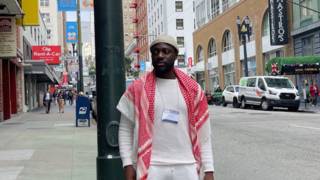
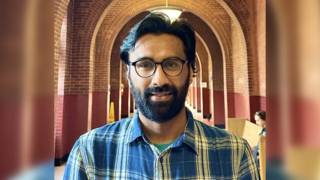
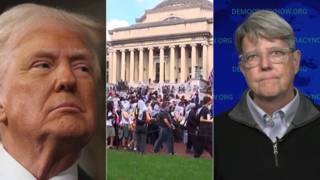
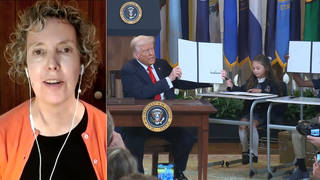



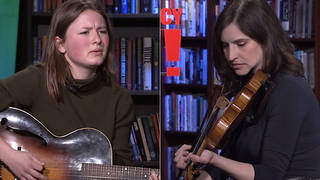

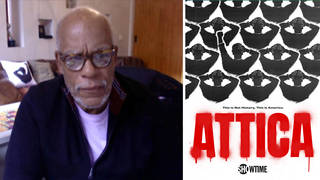
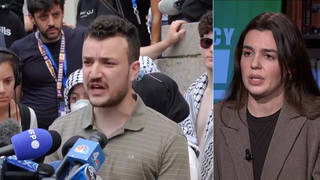
Media Options